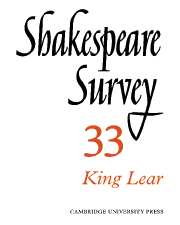Book contents
- Frontmatter
- King Lear: A Retrospect, 1939–79
- Some Conjectures on the Composition of King Lear
- The War in King Lear
- King Lear: Art Upside-Down
- ‘And that’s true too’: King Lear and the Tension of Uncertainty
- The Taming of the Shrew and King Lear: A Structural Comparison
- Medium and Message in As You Like It and King Lear
- Playing King Lear: Donald Sinden talks to J. W. R. Meadowcroft
- Hamlet’s Special Providence
- Antony and Cleopatra: ‘The Time of Universal Peace’
- Patterns of Motion in Antony and Cleopatra
- Theme and Structure in The Winter’s Tale
- Peter Street at the Fortune and the Globe
- English Actors at the Courts of Wolfenbüttel, Brussels and Graz during the Lifetime of Shakespeare
- Shakespeare at Stratford and the National Theatre, 1979
- The Year's Contributions to Shakespearian Study 1 Critical Studies
- 2 Shakespeare’s Life, Times, and Stage
- 3 Textual Studies
- Index
- Plate Section
King Lear: A Retrospect, 1939–79
Published online by Cambridge University Press: 28 March 2007
- Frontmatter
- King Lear: A Retrospect, 1939–79
- Some Conjectures on the Composition of King Lear
- The War in King Lear
- King Lear: Art Upside-Down
- ‘And that’s true too’: King Lear and the Tension of Uncertainty
- The Taming of the Shrew and King Lear: A Structural Comparison
- Medium and Message in As You Like It and King Lear
- Playing King Lear: Donald Sinden talks to J. W. R. Meadowcroft
- Hamlet’s Special Providence
- Antony and Cleopatra: ‘The Time of Universal Peace’
- Patterns of Motion in Antony and Cleopatra
- Theme and Structure in The Winter’s Tale
- Peter Street at the Fortune and the Globe
- English Actors at the Courts of Wolfenbüttel, Brussels and Graz during the Lifetime of Shakespeare
- Shakespeare at Stratford and the National Theatre, 1979
- The Year's Contributions to Shakespearian Study 1 Critical Studies
- 2 Shakespeare’s Life, Times, and Stage
- 3 Textual Studies
- Index
- Plate Section
Summary
Throughout the period under review there has been a wide measure of agreement that King Lear is the greatest of all the plays, and, perhaps as a consequence, an equally wide measure of disagreement about what it says. In the course of the many scrutinies it has been subjected to, almost every significant word in it has been examined with minute care, as though the drama were an extended metaphysical poem; yet, paradoxically enough, there is no general consensus among editors as to what Shakespeare actually wrote; and editions differ greatly from one another in the texts they offer. G. K. Hunter, for example, in his New Penguin edition first published in 1972, lists well over a hundred readings in which his text does not concur with those of Peter Alexander (1951), Kenneth Muir (1952), and Dover Wilson and G. I. Duthie (1960). The prime cause of the variations is, of course, that there are two substantive texts not one: the Quarto of 1608, containing some 300 lines not found in the Folio, and the Folio itself, containing 100 lines not found in the Quarto. The editor must, therefore, or has hitherto felt that he must, make use of both while knowing full well, to complicate his task still further, that neither of them was set up from a manuscript in Shakespeare’s hand. Nevertheless, one great advance has been made. In a classic study, published in 1940, W. W. Greg established conclusively that the Quarto of 1608, in a copy which, like all extant copies, was made up of both corrected and uncorrected sheets, was used for setting the Folio text.
- Type
- Chapter
- Information
- Shakespeare Survey , pp. 1 - 12Publisher: Cambridge University PressPrint publication year: 1981



